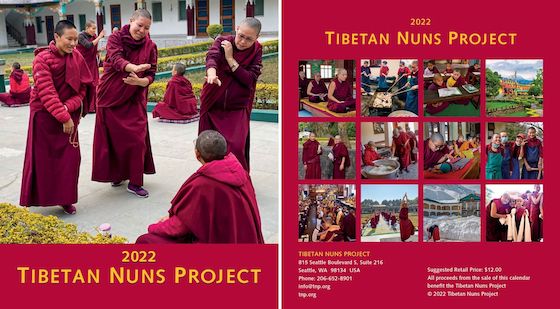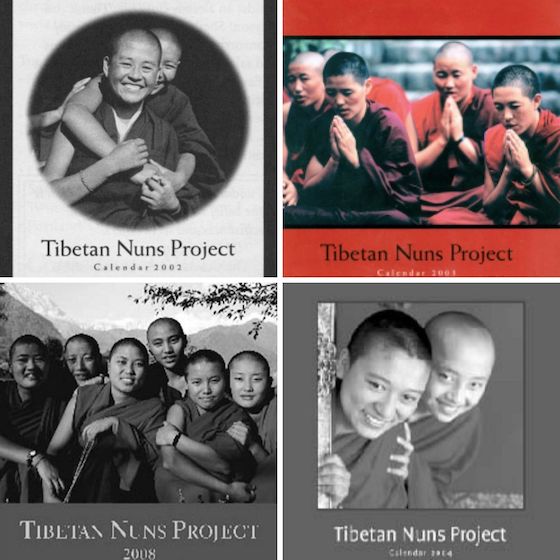Each year, the Tibetan Nuns Project sells a wall calendar through our online store. Our Tibetan Nuns Project calendar is available for order now.
The Tibetan Calendar vs. the Gregorian Calendar
The Tibetan calendar is thousands of years old. It differs from the Gregorian calendar, which is the international standard used almost everywhere in the world for civil purposes. The Gregorian calendar modified the earlier Julian calendar, reducing the average year from 365.25 days to 365.2425 days and spacing leap years.
While the Gregorian calendar is a purely solar calendar, the Tibetan calendar (Tibetan: ལོ་ཐོ, Wylie: lo-tho) is a lunisolar calendar. This means that the Tibetan year has either 12 or 13 lunar months, each beginning and ending with a new moon. A thirteenth month is added every two or three years so that an average Tibetan year is equal to the solar year.

Our 2022 calendar is available through our online store and all proceeds help provide education, food, shelter, clothing, and healthcare to Tibetan Buddhist nuns in India.
In the traditional Tibetan calendar, each year is associated with an animal, an element, and a number. The year of the Water Tiger, 2149, begins on March 3, 2022.
The animals in the Tibetan calendar are similar to those in the Chinese zodiac and are in the following order: Mouse, Ox, Tiger, Rabbit, Dragon, Snake, Horse, Sheep, Monkey, Bird, Dog, and Boar. The five elements are in this order: Wood, Fire, Earth, Iron, and Water.

One of the photos from the 2022 calendar from the Tibetan Nuns Project. All photos were taken by the nuns themselves and sales help to support the nunneries and nuns.
Tibetan New Year vs. Chinese New Year
Next year, starting at Tibetan New Year or Losar on March 3, 2022, it will be the year of the Water Tiger, 2149.
The Tibetan calendar follows three systems: solar day for a day, lunar day for a month, and zodiacal day for a year. The Chinese system of calendar follows the solar day system.
The dates for a new year in the Tibetan astrological system are cast according to the lunar calendar system, which has 371 days in a year, By contrast, the solar calendar system has 365 days in a year.
These few extra days in a lunar system accumulate to an extra month in a period of three years and it is thus balanced as a Da-Shol in the Tibetan astrological calendar system.
The Story of the Tibetan Nuns Project Calendar
The Tibetan Nuns Project calendar was started over 20 years ago as a fundraising and friend-raising tool to help support hundreds of Tibetan Buddhist nuns at nunneries in northern India.

A selection of some of the early Tibetan Nuns Project charity calendars from 2002 to 2008. The Tibetan Nuns Project wall calendar is now full color and uses photos taken by the nuns themselves.
The astrologers at the Tibetan Medical and Astrological Institute in Dharamsala (also known as Men-Tsee-Khang) supply us with the dates for the year’s Tibetan Buddhist holidays and holy days. It should be noted that the timings of the solstices and equinoxes in the calendar are based on north-eastern India where the nuns live so they may be slightly different from where you are.
The Tibetan Nuns Project calendar uses photographs taken by the nuns themselves. These photographs provide an intimate insight into the daily lives and religious and cultural practices of the nuns.

Photo of Tibetan Buddhist nuns doing yoga from the 2022 calendar.
Each summer, the nunneries that we support send a selection of photos for possible inclusion in the upcoming calendar. Once all the photos are gathered together, a final selection is made. We try to balance the images, choosing at least one photograph from each nunnery and selecting photographs that are windows into the nuns’ lives.
Each photo is captioned and paired with inspirational quotations from renowned Tibetan Buddhist teachers, such as His Holiness the Dalai Lama.
“It’s really exciting to open up emails from India and see the photos sent by the nunneries for possible inclusion in the calendar,” says Lisa Farmer, Executive Director of the Tibetan Nuns Project.
The proceeds from the sale of the Tibetan Nuns Project calendar are used to support over 700 Tibetan Buddhist nuns and seven nunneries in India. The calendar cost $12 plus shipping and is 6.5″ x 7″.
Thank you for buying our 2022 Tibetan Nuns Project calendar and helping the nuns!

Hi – I hope its ok i just shared a photo of the nuns doing yoga and the link to your calendar website on our Facebook page for Yoga Kids Training Academy. I hope it will be good advertising for you in Australia!
Wishing you Tashi Deleg for the new year and many warm wishes from Australia! 🙂 Emily
Thank you, Emily! Tashi Delek to you! We are grateful that you are spreading the word and sharing the news of the calendar in Australia.